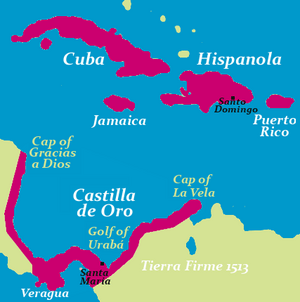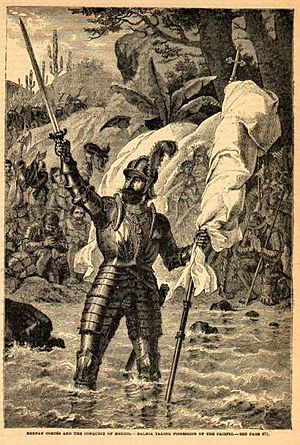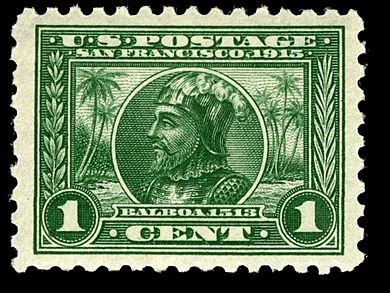Vasco Núñez de Balboa facts for kids
Quick facts for kids
Vasco Núñez de Balboa
|
|
|---|---|
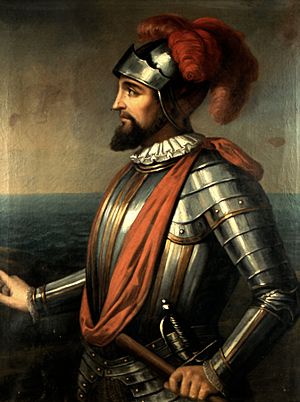
Vasco Núñez de Balboa
|
|
| Born | c. 1475 Jerez de los Caballeros, Spain
|
| Died | January 1519 (aged c. 43–44) Acla, Panama
|
| Occupation | Maritime explorer for the Crown of Castile |
| Spouse(s) | María de Peñalosa |
| Signature | |
 |
|
Vasco Núñez de Balboa (born around 1475, died January 1519) was a Spanish explorer, governor, and conqueror. He is famous for being the first European to lead an expedition across the Isthmus of Panama to reach the Pacific Ocean in 1513. This made him the first European to see or reach the Pacific from the Americas.
He traveled to the Americas in 1500. After some exploration, he settled on the island of Hispaniola. In 1510, he founded Santa María la Antigua del Darién in what is now Colombia. This was the first lasting European settlement on the mainland of the Americas.
Contents
- Balboa's Early Life and First Journey
- Starting a New Settlement
- Founding Santa María la Antigua del Darién
- Balboa Becomes a Leader
- Governor of Veragua
- Balboa the Conqueror
- The Discovery of the Pacific Ocean
- Claiming the South Sea
- Challenges with Pedrarias
- Balboa's Downfall and Death
- Balboa's Legacy
- Images for kids
- See also
Balboa's Early Life and First Journey
Balboa was born in Jerez de los Caballeros, Spain. He came from a noble family. Not much is known about his early childhood. He was the third of four boys. As a teenager, he worked for Don Pedro de Portocarrero, a lord from Moguer.
In 1500, Balboa was inspired by news of Christopher Columbus's trips. He decided to go on his first voyage to the Americas. He joined an expedition led by Rodrigo de Bastidas. Bastidas had permission to collect treasure for the king and queen. In 1501, Balboa explored the Caribbean coasts of Panama and Colombia. The expedition then sailed to Hispaniola.
With his share of the earnings, Balboa settled in Hispaniola in 1505. He tried farming and raising pigs, but he was not successful. He ended up in debt and had to leave the island.
Starting a New Settlement
In 1508, the king of Spain, Ferdinand II, decided to conquer Tierra Firme. This area is roughly the Isthmus of Panama. He divided it into two parts. The Gulf of Urabá was the border. Nueva Andalucía was to the east, led by Alonso de Ojeda. Veragua was to the west, led by Diego de Nicuesa.
In 1509, Balboa wanted to escape his debts in Santo Domingo. He secretly boarded a ship, hiding in a barrel with his dog. The ship was part of an expedition led by Martín Fernández de Enciso. Enciso was going to help Alonso de Ojeda.
Ojeda had founded a settlement called San Sebastián de Urabá. But the local natives fought back with poisoned weapons. Ojeda was hurt and left the settlement under Francisco Pizarro's care. Pizarro was just a soldier at the time.
Enciso found Balboa on the ship. He first threatened to leave him on an island. But he changed his mind. Balboa knew the region well from his earlier travels. This knowledge was very useful.
After 50 days, Pizarro was ready to leave San Sebastián. Then Enciso's ship arrived. Balboa was popular with the crew because he was charismatic and knew the area. Enciso, however, was not well-liked. The settlement of San Sebastián was destroyed. The natives were attacking constantly.
Founding Santa María la Antigua del Darién
Balboa suggested moving the settlement to the Darién region. This area was west of the Gulf of Urabá. The soil was better there, and the natives seemed less hostile. Enciso agreed. They went to Darién, where the native leader, cacique Cémaco, was waiting with 500 warriors.
The Spanish were scared by the large number of enemies. They promised the Virgen de la Antigua that they would name a settlement after her if they won. The battle was tough, but the Spanish won.
Cémaco and his warriors left for the jungle. The Spanish found a lot of gold ornaments in the houses. Balboa kept his promise. In September 1510, he founded the first lasting European settlement on the American mainland. He named it Santa María la Antigua del Darién.
Balboa Becomes a Leader
The Spanish victory and the founding of Santa María made Balboa respected. His companions did not like Enciso, whom they saw as greedy.
Balboa used this situation to his advantage. He spoke for the unhappy settlers. He removed Enciso from his position. Balboa argued that Enciso's authority was not valid. This was because Enciso was in Veragua, which was Nicuesa's territory, not Ojeda's. So, Enciso was arrested. After Enciso was removed, the settlers elected a new council. Balboa was chosen as one of the two leaders.
Soon after, a group of ships arrived. They were looking for Nicuesa. When they heard what happened, they convinced the settlers to accept Nicuesa's authority. Their land was under his control. Two representatives from Santa María went with the ships to offer Nicuesa control of the city.
Governor of Veragua
The ships found Nicuesa near Nombre de Dios. He was badly hurt and had few men left after fighting with natives. Nicuesa heard about Balboa's success and Santa María's wealth. He promised to punish Balboa for challenging his authority.
However, a prisoner named Lope de Olano warned Santa María's representatives. He said Nicuesa was cruel and would ruin the city. The representatives quickly returned to Darién. They told Balboa and the leaders about Nicuesa's plans.
When Nicuesa arrived at the city's port, a crowd stopped him from landing. Nicuesa begged to be allowed in, even as a simple soldier. But the colonists refused. He and 17 others were forced onto a small, unseaworthy boat. They were put out to sea on March 1, 1511. The ship disappeared, and Nicuesa was never seen again. This made Balboa the governor of Veragua.
Balboa the Conqueror
As governor, Balboa had full power in Santa María and Veragua. One of his first actions was to put Enciso on trial. Enciso was found guilty of taking the governor's power. He was jailed and his belongings were taken. Balboa soon freed him, but Enciso had to return to Spain. Balboa also sent two representatives to Spain to ask for more men and supplies.
Balboa continued to explore. He defeated some native tribes and made friends with others. He searched for gold and expanded his territory. He kept his men in line and earned respect from the natives. He wrote to the King of Spain, saying he had to be a peacemaker during his trips.
He successfully grew corn and received supplies from Hispaniola and Spain. His men got used to exploring new lands. Balboa collected a lot of gold.
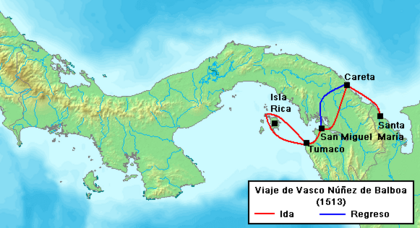
In late 1512 and early 1513, he reached the land of cacique Careta. Balboa easily defeated Careta and then became his friend. Careta was baptized and became a strong ally. He promised to provide food for the Spanish. Balboa then moved on to the lands of Careta's rival, cacique Ponca. Ponca fled, and his village was plundered. Days later, the expedition reached the lands of cacique Comogre. Comogre welcomed Balboa peacefully and was also baptized.
In Comogre's lands, Balboa first heard about "the other sea." Spanish soldiers were arguing over small amounts of gold. Comogre's son, Panquiaco, was angry. He knocked over the gold scales and said: "If you are so hungry for gold, I will show you a place where you can find enough." Panquiaco told them about a rich kingdom to the south. People there ate and drank from gold plates. But he warned that they would need at least a thousand men to defeat the tribes there and on the coast of "the other sea."
The Discovery of the Pacific Ocean
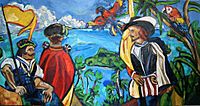
Balboa was very interested in the news of a new, gold-rich kingdom. He returned to Santa María in early 1513 to get more men. He learned that Enciso had told the Spanish authorities about what happened in Santa María. Since no help was coming from Hispaniola, Balboa sent Enrique de Colmenares directly to Spain to ask for help.
Balboa's request for men and supplies was denied. So, Balboa had to start his expedition with the few resources he had in Santa María.
Using information from friendly native leaders, Balboa began his journey across the Isthmus of Panama on September 1, 1513. He had 190 Spaniards, some native guides, and dogs. They sailed along the coast and landed in Careta's territory. On September 6, the expedition continued with 1,000 of Careta's men. They entered Ponca's land. Ponca attacked but was defeated and forced to join Balboa.
After a few days, the expedition entered the dense jungle on September 20. Four days later, they reached the lands of cacique Torecha. A fierce battle took place, and Torecha was killed. Torecha's followers then joined the expedition. Many men were tired and wounded, so they rested in Torecha's village.
The next day, the remaining men continued with Balboa. They entered the mountains along the Chucunaque River. Natives said the South Sea could be seen from the top. Balboa went ahead. Before noon on September 25, he reached the summit. He saw the waters of the undiscovered sea far in the distance. Everyone was overjoyed. The expedition's chaplain sang a prayer. The men built stone pyramids and carved crosses on trees to mark the spot.
Claiming the South Sea
After seeing the sea, the expedition went down the mountain towards the coast. They arrived in the lands of cacique Chiapes. Chiapes was defeated and invited to join them. From Chiapes' land, three groups searched for routes to the coast. One group, led by Alonso Martín, reached the shore two days later. They took a canoe for a short trip, becoming the first Europeans to sail the Pacific Ocean off the New World coast.
Martín told Balboa, who then marched to the coast with 26 men. Once there, Balboa raised his hands, holding his sword in one and a flag with the Virgin Mary in the other. He walked knee-deep into the ocean. He claimed the new sea and all nearby lands for the Spanish rulers.
After traveling over 110 kilometers (70 miles), Balboa named the bay San Miguel. This was because they arrived on September 29, the feast day of Archangel Michael. He named the new sea Mar del Sur (South Sea) because they had traveled south to reach it.
Balboa's main goal was to find the gold-rich kingdoms Panquiaco had spoken of. He traveled through the lands of caciques Coquera and Tumaco. He easily defeated them and took their gold and pearls. He learned that pearls were plentiful in the islands ruled by Terarequí. Balboa sailed to these islands in canoes. He named the largest one Isla Rica (Rich Island), now known as Isla del Rey. He named the whole group Archipiélago de las Perlas, which they are still called today.
In November, Balboa decided to return to Santa María. He took a different route to explore more territory and find more gold. He passed through several regions, fighting some tribes and making friends with others. He had a bloody battle against cacique Tubanamá, but Balboa won. In December, the expedition reached the Caribbean coast. From there, he went to Comogre's lands, finding that his old ally had died. His son, Panquiaco, was now the leader.
From there, he crossed the lands of Ponca and Careta. He arrived back in Santa María on January 19, 1514. He brought a lot of treasure, including cotton goods, over 100,000 gold coins, and many pearls. But the biggest discovery was the South Sea for Spain. Balboa sent Pedro de Arbolancha to Spain with news of this discovery. He also sent one-fifth of the treasure to the king, as required by law.
Challenges with Pedrarias
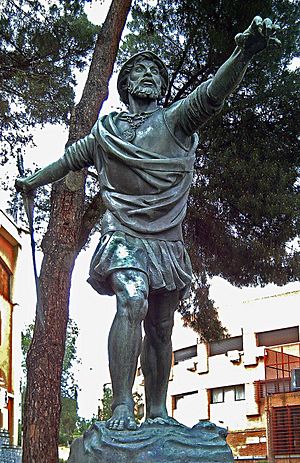
Enciso's accusations and the disappearance of Governor Ojeda led the king to appoint Pedro Arias de Ávila as governor of the new province, Castilla de Oro. Arias, known as Pedrarias Dávila, arrived from Spain in July 1514. He brought a large expedition of 1,500 men and 17 ships. This was the biggest expedition to leave Spain for the Americas at that time.
Pedrarias was accompanied by important people, including Enciso, who was now Chief Constable. Many men died from hunger or disease soon after reaching Darién.
Balboa welcomed Pedrarias and accepted his replacement as governor. However, the settlers did not like the change. Some wanted to fight Pedrarias, but Balboa showed respect to the new authorities.
As soon as Pedrarias took charge, he had Balboa arrested. Balboa was ordered to pay money to Enciso and others. But he was found innocent of killing Nicuesa, so he was freed soon after.
Because Santa María was overcrowded, Pedrarias sent explorers to find new settlement sites. Balboa asked to explore the Dabaibe region, where there were rumors of a rich temple. This expedition failed, and Balboa was wounded.
Balboa still wanted to explore the South Sea. He secretly arranged for men from Cuba to join him. Pedrarias found out and was furious. He had Balboa arrested again and planned to punish him severely. But Bishop de Quevedo stopped him, asking him not to abuse his power.
Luckily for Balboa, the Spanish Crown finally recognized his important work. The king gave him the titles of "Adelantado of the South Seas" and "Gobernador of Panama and Coiba". The King also told Pedrarias to treat Balboa with great respect. Because of this, Pedrarias had to release Balboa and drop all charges against him.
Balboa's Downfall and Death
The rivalry between Balboa and Pedrarias stopped for a while. Bishop de Quevedo and Isabel de Bobadilla helped arrange Balboa's marriage to María de Peñalosa, one of Pedrarias' daughters. She was in Spain, so they never met. The friendship between Pedrarias and Balboa lasted only about two years.
Balboa wanted to keep exploring the South Sea. Pedrarias tried to delay him. But because of their new family connection, Pedrarias finally allowed Balboa to go on a new expedition for a year and a half.
In 1519, Balboa moved to Acla with 300 men. He used native workers and African slaves to gather materials for new ships. He built four ships on the Balsas River (Río Balsas). He traveled 74 kilometers (46 miles) through the Pacific, exploring the Pearl Islands and the coasts of Darién. He named Puerto Piñas because of the many pineapples he found there. He then returned to Acla to build stronger ships.
When he returned, Pedrarias sent friendly letters asking Balboa to meet him. Balboa quickly obeyed. Halfway to Santa María, he met soldiers led by Francisco Pizarro. They arrested him for trying to take Pedrarias' power and create his own government in the South Sea. Balboa denied the charges and demanded to be taken to Spain for trial. But Pedrarias ordered the trial to happen right away.
Balboa's trial began in January 1519. On January 15, he was sentenced to death. Four of his friends were also sentenced to death as accomplices. The executions took place in Acla.
Pedrarias watched the execution from a hidden spot. Gaspar de Espinosa, Pedrarias' assistant, sailed the South Sea on the ships Balboa had built. In 1520, Ferdinand Magellan renamed the sea the Pacific Ocean because of its calm waters.
Balboa's Legacy
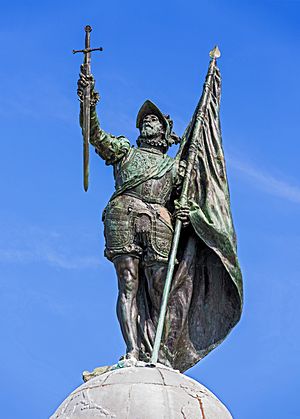
Even though Balboa died young, his actions are remembered. He was the first European to cross the Americas. Many parks and streets in Panama are named "Vasco Núñez de Balboa." Monuments honor his discovery of the South Sea. The Panamanian money is called the Balboa, and his face is on most Panamanian coins.
His name is also given to Panama City's main port, Balboa, and the Balboa District in Panamá Province. The Pearl Islands he discovered are part of this district. There is also a Panamanian beer named after him.
In San Francisco, California, USA, Balboa's name is on an avenue in the Balboa Park neighborhood. There is also Balboa High School. A large park in San Diego, California, called Balboa Park, was named after him in 1910. Balboa is also honored in Madrid with a street and a metro station.
One of the highest awards given by the Panamanian government is the Orden Vasco Núñez de Balboa. This award honors important people from Panama and other countries.
The lunar crater Balboa on the Moon is named after him.
Balboa is mentioned in the song "The Great Nations of Europe" by Randy Newman.
Vasco Nunez de Balboa was featured on the 1-cent stamp for the Panama-Pacific Exposition in 1913. This stamp was used for postcards and with other stamps for larger mail or foreign destinations. Over 330 million of these stamps were made.
SENAN's Naval Base Vasco Nuñez de Balboa in Panama City is named for Balboa.
In 2020, Iberdrola built the Núñez de Balboa Photovoltaic Power Plant in Usagre, Spain. With 500MW, it was the biggest photovoltaic power station in Europe at the time.
Images for kids
See also
 In Spanish: Vasco Núñez de Balboa para niños
In Spanish: Vasco Núñez de Balboa para niños


